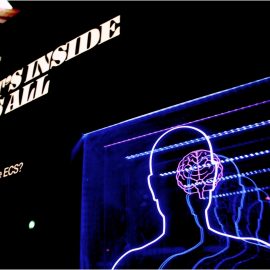

This article is an excerpt from the Shortform book guide to "The Man Who Mistook His Wife for a Hat" by Oliver Sacks. Shortform has the world's best summaries and analyses of books you should be reading.
Like this article? Sign up for a free trial here .
Who was Dr. P from The Man Who Mistook His Wife for a Hat? What did Dr. P’s case teach author Oliver Sacks about left-hemisphere damage?
In the book of psychological case studies, The Man Who Mistook His Wife for a Hat, Dr. P was a patient who suffered from left-hemisphere damage and had trouble identifying what he was seeing. In fact, the book is named after Dr. P because he did, literally, mistake his wife’s head for a floating hat.
Continue on for more information about the case study of Dr. P. in The Man Who Mistook His Wife for a Hat
The Agnosia of Dr. P
Neurologists often speak of brain disorders in terms of deficits. A deficit is some impairment of neurological function, usually linked to brain damage to some particular area. Damage to Broca’s area, for example, is known to cause aphasia—the inability to process and understand written or spoken language.
We can see a clear example of a neurological deficit in the strange case of Dr. P from The Man Who Mistook His Wife for a Hat, a distinguished professor of music. Author Oliver Sacks met with Dr. P after the man’s wife reported that her husband was having strange problems with visual recognition.
This manifested in bizarre ways. Dr. P seemed to be unable to recognize the faces of his students and only knew them when they spoke or played their instruments. He also had the opposite problem—seeing faces where there were none. To the bafflement of observers, Dr. P was known to pat inanimate objects like parking meters and fire hydrants, thinking they were children.
When Dr. P went to an ophthalmologist, he discovered that his eyes were not the problem. Dr. P suffered instead from agnosia—an inability to recognize and interpret visual data. He could observe the visual world around him but derive no holistic meaning from it.
Left-Hemisphere Problems
Sacks’ initial examination revealed that Dr. P was having problems with the left side of his brain. Sacks identified a few symptoms of Dr. P’s condition immediately:
- He could generally see well, but could not identify objects if they were placed on his left side.
- When asked to describe an imaginary walk down the streets in the center of his town, Dr. P could only describe the buildings on his right side. When asked to imagine the same walk through the town center but approaching from the opposite way, he also described only those buildings on his right side—but this time, they were the buildings on the side of the street he had omitted in his initial description.
Sacks found that Dr. P could not identify the faces in photographs of friends and family. Those he could recognize were those with distinct features—he identified a photo of his brother by noting his brother’s square jaw and big teeth.
But even this was only further evidence of his condition. He was identifying only the features and using them as a clue to guess the identity of the person, but he was not truly recognizing them. He was missing the forest for the trees, using characteristics as clues to unlock the puzzle of the unrecognizable world in which he lived. This also explained why he could identify highly stylized cartoon drawings, abstract shapes, or playing cards, but struggled to identify his own wife—whose head he often grabbed at, believing it was a hat.
Similarly, Dr. P could identify the individual features of objects, but never define what the object was as a whole. To him, a rose was “a convoluted red form” with a strange green tube attached to it.
Surpluses
Although Dr. P had lost the power of visual narrative, his mind seemed to compensate for this deficit by crediting his neurological “account” in other ways. As we saw with his rich and detailed descriptions of the features of objects like flowers or gloves, it was clear that Dr. P had exceptional powers of abstract description. This was one of the ways in which Dr. P managed to service meaning from his world. A clear manifestation of this was how he excelled at schematic mental models involving abstract shapes—he was a skillful player of blind chess, able to perfectly visualize the board and pieces on his mind.
His already prodigious musical skills were another means by which Dr. P held his atomized world together. Dr. P was only able to perform the routine functions of daily life by means of music. His clothes had to be laid out in the same precise way every day and he had to maintain a musical rhythm while he dressed himself. Any change or interruption would render him unable to complete the task. Thus, his life was ordered like a carefully orchestrated opera, each note and beat guiding him through his days.
Sacks recommended that Dr. P commit to living a life entirely consisting of music. Music was one of the gifts Dr. P’s brain had given him to compensate for his devastating impairment, providing him a tool to order, recognize, and make sense of his world.

———End of Preview———
Like what you just read? Read the rest of the world's best book summary and analysis of Oliver Sacks's "The Man Who Mistook His Wife for a Hat" at Shortform .
Here's what you'll find in our full The Man Who Mistook His Wife for a Hat summary :
- Neurologist Oliver Sacks' case studies on patients with neurological impairments
- The remarkable complexity of the human brain and its extraordinary capacity to adapt
- How Sacks' work with his patients shows the pitfalls of traditional thinking about neurological disorders






